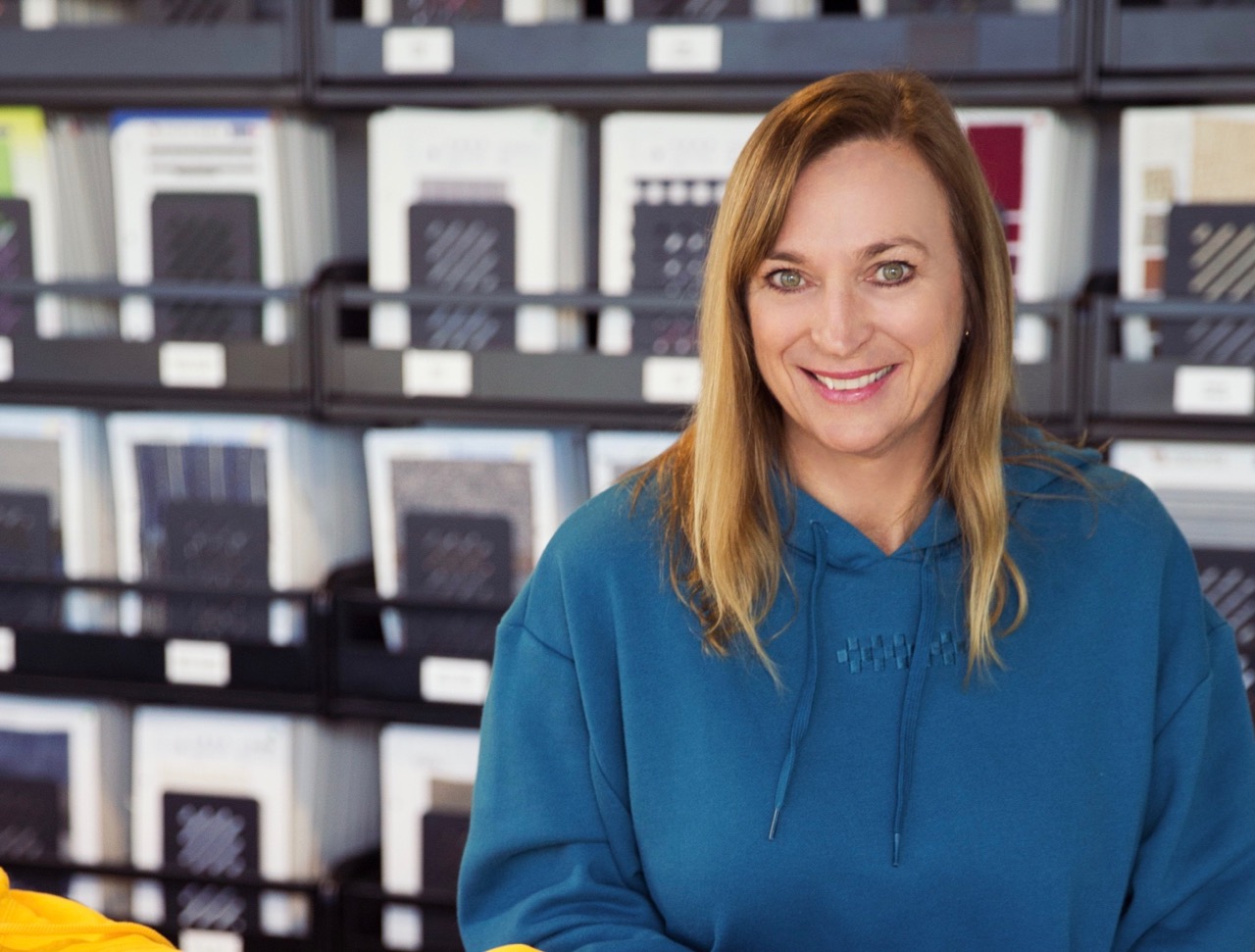Vans VP of Apparel Vicki Redding has had an interesting career in the industry.
She got her start working the floor at Nordstrom, where she eventually became a buyer, and then moved to Quiksilver, DC and the La Jolla Group before joining Vans. Vicki has overseen explosive growth in Vans apparel since she joined the company in 2012.
We asked Vicki about how her Nordstrom training helped her career, what it was like to work at Quiksilver in the industry’s heyday, and how she and her team at Vans have changed the way they work because of the pandemic.
How did you get into the business?
Vicki Redding: I realized when I was in high school that I wanted to get into the apparel industry. I didn’t know what that looked like or how that would take form, but I knew then that I wanted a career in clothing.
Why was that? Were you really into clothes?
Vicki Redding: Yes, I was. I was taking sewing classes and working part-time at a department store. I loved the energy of it all. Nordstrom started opening stores in California, and I was fortunate to get a job there. At the time they always promoted from within. I started on the selling floor, was promoted to department manager, and was promoted to buyer one year later.
At the time I was going to junior college, but as soon as I was promoted to buyer, I dropped out of school, which I wouldn’t recommend to anyone today.
I’d say it worked out okay for you.
Vicki Redding: It did, I was the Orange County buyer for the boys’ department. It was an amazing launching pad for me.
And we’re going back to late 80s, early 90s, I was buying Quiksilver, Gotcha, Stussy, Jimmy Z – all the brands that were hot at the time.
This would never happen nowadays, but I would drive my car to the Quiksilver warehouse in Costa Mesa, get boxes of their excess inventory, drive back to South Coast Plaza, ticket the product with my stockperson, and then get it on the selling floor. Tom Holbrook was actually my sales rep at the time.
Business was amazing and I loved the interaction with the action sports industry. I was at Nordstrom for nine years, seven as a buyer, and then I received a call from Seth Ellison at Quiksilver asking if I would be interested in coming to this side of the business. I said yes and the rest is history.
What was your first job at Quiksilver?
Vicki Redding: With my background and knowledge as a boys’ buyer, they brought me in to oversee boys’ design and merchandising which was a fairly new division for them. This was back in the early 90’s.
What was Quiksilver like at that time?
Vicki Redding: How do I say this diplomatically? It was very loose. It was very free. It was the old days in the industry.
Was it fun?
Vicki Redding: Oh my gosh yes, I loved it. There was definitely a transition period, going from this very corporate environment where you were wearing heels every day to this very relaxed culture. It definitely took me a minute to embrace it.
At Nordstrom, if there was a meeting at 9 am, you better be in your seat at 9 am. At Quiksilver in those days, that 9 could mean 10.
There were times that were intense and stressful but those are the times I look back on and realize they made me a stronger person.
How long were you at Quiksilver?
Vicki Redding: In total, I was there for 17 years. The last two years were at DC and prior to that, I had a few different roles overseeing men’s and boys’ product creation for the Americas and then global products for men’s and boys’.
Were there any key bosses there or key lessons you learned or things that really stand out?
Vicki Redding: The biggest thing I’ve learned throughout my career is the importance of building a strong team. It’s never about one person. It’s always about having a team that can work together with a clear vision, that’s when the magic happens.
Tell me about coming to Vans after a stop at La Jolla Group. When you started at Vans, I think the apparel piece was pretty small?
Vicki Redding: Yes, it was relatively small. When I was at La Jolla Group shopping the market and looking at our competitors, I actually saw this amazing runway for Vans apparel. At the time I started seeing these small collections of Vans apparel out in the market and I thought they were poised to start making traction.
And one day, I received a call from someone at Vans that I had previously worked with, who asked if I would be interested in submitting my resume for VP Global Product in Apparel. The role just opened, and this person thought I would be a good fit.
I said, “Yes, I’d love to talk to them.” It took six months, a lot of interviews, and here I am eight years later. I am still thankful today that I was offered this role. It has been a lot of hard work but such an amazing brand to work for. I feel very blessed.
How big was apparel when you got here?
Vicki Redding: $240 million.
And your goal is to reach $1 billion if I remember correctly? How close are you?
Vicki Redding: Yes, that is our goal and are striving to reach that milestone within the next few years.
What qualities do you appreciate in direct reports?
Vicki Redding: They must have passion for product, have a growth mindset, and be adaptable to change. And of course they must work well as a team – no big egos.
As the business has grown it has also been important to look for people from diverse backgrounds and look outside our industry. They can bring a new perspective which is always good to keep things moving forward.
How do you manage it all? Any tips for the emails, the meetings, the presentations, etc.?
Vicki Redding: Oh, gosh, Tiffany. I am not a good person to give advice on this. I don’t have the best work life balance and if I said I did, I think my team would call me out on it.
But in all seriousness, you have to trust and rely on your team. And I have an amazing team in place, but yes I do work a lot.
But to me, it’s just part of it. I love it, and it energizes me.
How has the pandemic changed how you and your team work?
Vicki Redding: It has changed significantly! When everything shutdown back in March we were in the middle of designing a global line for Fall ‘21 along with approving and fitting protos for Spring ‘21.
The design, merchandising and development teams had to act quickly, work together and come up with solutions to keep everything moving forward. We are now using virtual meetings for design reviews, prototype approvals, fittings and merchandising the overall assortment.
Another major change has been in response to travel restrictions. In the past, regional merchandising teams would fly in from Europe and Asia to review the seasonal assortment. Now those meetings have become virtual starting at 5:30 am to ensure we are capturing input from all the regions.
The global product team was also traveling quite often for market visits and development meetings internationally. We are realizing we can still get the job done. It’s not always easy, but we are making it work. We are also fast tracking our use of 3D assets to enhance sell in.
Overall the shutdown has increased our communication and collaboration not only within our own team but cross functionally and across all regions. It has forced us to become much more agile!
Are there any interesting lessons you have learned during this crisis?
Vicki Redding: Yes, absolutely. There was always this stigma about working from home, and people questioned how can we possibly get everything done when we aren’t together in the office. This crisis has proved to us that we can absolutely work from home and the work will get done and in some cases get done more efficiently.
We are realizing people who had a long commute are actually more productive because they are not sitting in their cars for two-plus hours a day. We have also realized if we open up capacity and bandwidth within the team we can work on collections that are much closer to market and become proactive versus reactive.
I believe the pandemic has forced us to “rip the band-aid off” and make changes that we spoke about but never actually moved forward with. We are now looking at what changes can become permanent and continue to be agile, closer to market and digitally led.






